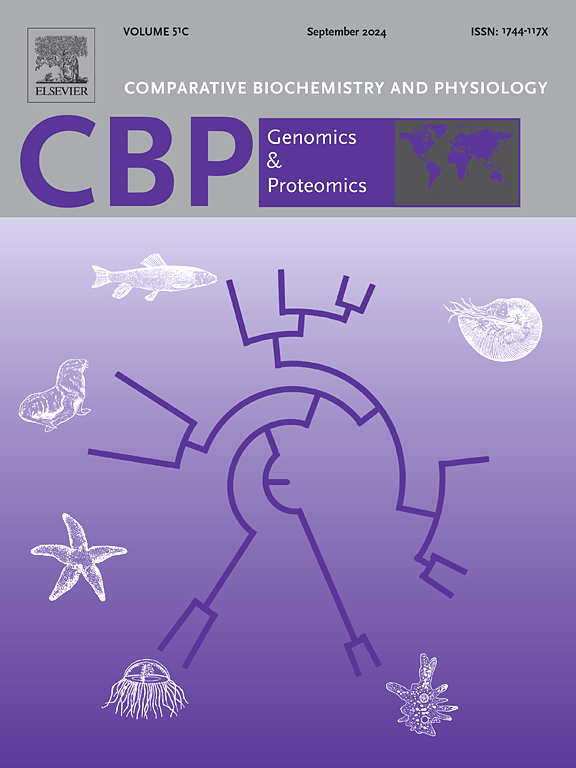Lipid droplets play versatile roles in ovarian development of the razor clam Sinonovacula constricta: Insights from proteomic and lipidomic analyses
IF 2.2
2区 生物学
Q4 BIOCHEMISTRY & MOLECULAR BIOLOGY
Comparative Biochemistry and Physiology D-Genomics & Proteomics
Pub Date : 2025-04-24
DOI:10.1016/j.cbd.2025.101519
引用次数: 0
Abstract
Lipid droplet (LD) deposition is a common phenomenon during ovarian development across marine mollusks; however, studies on the protein and lipid composition of their ovarian LDs remain limited. Here, we purified LDs from the ovaries of Sinonovacula constricta and isolated proteins and lipids from these purified LDs for proteomic and lipidomic analyses. Our proteomic analysis identified 3243 proteins, with PLIN2 being the most abundant (37.03 ± 13.56 %). We subsequently conducted a functional analysis of the top 500 most abundant LD-associated proteins, categorizing them into 15 groups, including those involved in lipid metabolism, sterol biosynthesis, tricarboxylic acid cycle, carbohydrate metabolism, G protein superfamily, protein chaperones, transport proteins, nucleotide-catabolic process, protein processing and degradation, cytoskeletal proteins, oxidative stress and immunity, and ribosome-associated proteins. In our lipidomic analysis, we identified 1158 molecules across 52 lipid classes, with phosphatidylcholine (PC) exhibiting the greatest diversity at 209 varieties, followed by EtherPC with 177 varieties and triglyceride (TG) with 149 varieties. The fatty acid (FA) analysis of LDs revealed that 16:0 was the most abundant (30.01 ± 0.42 %). Additionally, LDs were found rich in long-chain polyunsaturated FAs (35.63 ± 4.36 %), particularly EPA and DHA. Moreover, we analyzed the FA composition of TGs, PCs, and EtherPCs derived from ovarian LDs. In PCs and TGs, the predominant FAs were 16:0, 16:1, and 18:3, while 16:0, 22:6, and 18:4 constituted the major FA species in EtherPCs. Together, our results suggest that ovarian LDs in S. constricta not only participate in lipid metabolism but also interact with other organelles and metabolic processes, thereby facilitating ovarian development.

脂滴在剃刀蛤的卵巢发育中起着多种作用:来自蛋白质组学和脂质组学分析的见解
脂滴沉积是海洋软体动物卵巢发育过程中普遍存在的现象。然而,对其卵巢ld蛋白和脂质组成的研究仍然有限。本研究从缢蛏卵巢中纯化了lld,并从这些纯化的lld中分离出蛋白质和脂质进行蛋白质组学和脂质组学分析。蛋白质组学分析鉴定出3243个蛋白,其中PLIN2丰度最高(37.03±13.56%)。随后,我们对500个最丰富的ld相关蛋白进行了功能分析,将其分为15类,包括脂质代谢、甾醇生物合成、三羧酸循环、碳水化合物代谢、G蛋白超家族、蛋白伴蛋白、转运蛋白、核苷酸分解代谢过程、蛋白质加工和降解、细胞骨架蛋白、氧化应激和免疫以及核糖体相关蛋白。在我们的脂质组学分析中,我们鉴定了52个脂类中的1158个分子,其中磷脂酰胆碱(PC)表现出最大的多样性,有209个品种,其次是EtherPC,有177个品种,甘油三酯(TG)有149个品种。脂肪酸(FA)分析显示,16:0脂肪酸含量最高(30.01±0.42%)。此外,ld富含长链多不饱和脂肪酸(35.63±4.36%),尤其是EPA和DHA。此外,我们还分析了卵巢ld衍生的TGs、PCs和EtherPCs的FA组成。在PCs和TGs中,FA的优势种为16:0、16:1和18:3,而在EtherPCs中,FA的主要种类为16:0、22:6和18:4。综上所述,我们的研究结果表明,缢蛏卵巢ld不仅参与脂质代谢,还与其他细胞器和代谢过程相互作用,从而促进卵巢发育。
本文章由计算机程序翻译,如有差异,请以英文原文为准。
求助全文
约1分钟内获得全文
求助全文
来源期刊
CiteScore
5.10
自引率
3.30%
发文量
69
审稿时长
33 days
期刊介绍:
Comparative Biochemistry & Physiology (CBP) publishes papers in comparative, environmental and evolutionary physiology.
Part D: Genomics and Proteomics (CBPD), focuses on “omics” approaches to physiology, including comparative and functional genomics, metagenomics, transcriptomics, proteomics, metabolomics, and lipidomics. Most studies employ “omics” and/or system biology to test specific hypotheses about molecular and biochemical mechanisms underlying physiological responses to the environment. We encourage papers that address fundamental questions in comparative physiology and biochemistry rather than studies with a focus that is purely technical, methodological or descriptive in nature.

 求助内容:
求助内容: 应助结果提醒方式:
应助结果提醒方式:


